As an Amazon Associate I earn from qualifying purchases.
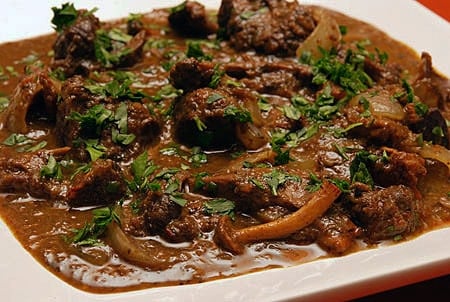
This post could be subtitled, “Why the French aren’t all bad.” But then I could also fall back on the fact that this recipe is equally well-known in Britain, where it is known as Jugged Hare. Civet de Lievre sounds so much better, though…
Pause for a moment and think about this recipe. Jugged hare, civet of hare, whatever you call it, this is a recipe George Washington would have known and probably ate. Hell, John Smith would have been able to eat an early version of jugged hare back in Jamestown a century before Washington — if he had access to some good wine.
Flash forward four centuries, and access to good wine is no longer an issue: Access to a hare is. Isn’t a hare a rabbit? Not in the least. Hares, mostly known as jackrabbits in the United States, live longer, run faster, are smarter and are generally tougher to eat — and to catch. Hares have red meat like beef, not white meat, like rabbits or chickens.
Can you buy a hare? Yes, but there is only one place I know of: D’Artagnan meats. But buying a wild Scottish hare will cost you more than $60. That’s about $15 per person, as a hare typically feeds four. I prefer to shoot jackrabbits, when I can find them. There is no season on them in California, so they are fair game all year long.
Scared off yet? I hope not, because civet of hare is a truly special dish. It is one of those recipes that hearkens back to the days of Brillat-Savarin, or Antonin Careme or Escoffier. This is the real deal, folks, and it ain’t easy to make. But it’s worth it.
Look at this lovely dish: Perfectly braised hare, tender, deeply flavored and meaty. It is accompanied by fresh chanterelle mushrooms, which are one of princes of the mycological realm. But the real hero of this dish is the sauce. Silky, rich, with a depth of flavor that makes you shut up and think about what you just put in your mouth — Oh yes, folks, civet of hare is definitely worth it.
My chief inspiration for my own version of jugged hare is Paula Wolfert’s The Cooking of Southwest France, and if you are a duck hunter (or just a lover of duck and goose) you really need this book. It has whole sections on what to do with every part of the bird, and has proved to be an invaluable resource in my own explorations of eating everything but the quack.
I made this dish last weekend with a jackrabbit I had frozen back in September. I get so few hares every year that I always feel the need to do something special with them. So I began my civet on Friday.
You need to marinate the hare in wine and brandy (with the alcohol burned off) for at least a day. Then you brown the hare and the vegetables from the marinade, then clarify the marinade itself.
The dish then needs nearly three hours of gentle heat to turn a tough old hare into a meltingly tender meal. And then there’s the sauce, which must be pushed through a food mill or otherwise blended. Don’t have a food mill? Buy one. I use mine almost every week. But you’re not done yet.
There is something different about a civet, or a jugged dish. Hares, by the by, aren’t the only animals “jugged.” Venison, ducks, geese, etc all appear cooked in this fashion. What they all have in common is that the sauce is thickened with the blood and liver of the animal, pureed with heavy cream. Pretty scary, eh? I thought so.
If you are a hunter, you will want to save some blood from the hare in a small container, mixed with a little red wine vinegar to preserve it. If not, you can either wrangle some pork blood from an Asian market or just skip it altogether. Blood is good to have, but not as critical as the liver.
Definitely keep the hare’s liver if you hunted it, although you will need to watch for sick livers — they will be striated, or have white specks in them or will look otherwise “not right.” And be sure to wear gloves when butchering rabbits and hares in California; there is a disease called tularemia that one in a million rabbits will be carrying. I have never seen it, but better safe than sorry.
Even safer would be to use a duck’s liver, or if you are not a hunter, a chicken liver or two. Buzz it in a food processor with the heavy cream and marvel at how disturbingly similar it looks to Strawberry Quik. Ew. No matter, this mixture gets stirred into your finished sauce to thicken it.
Why all this bother? Because back in the 17th and 18th centuries, adding blood and pureed livers was an accepted way to thicken a sauce and add flavor at the same time. Can you make an arrowroot or corn starch slurry and thicken your civet? Yes, but then it wouldn’t really be the same, now would it?
It is all a lot of work. But what’s important about all this is not so much that you attempt to make an authentic civet of hare. What isimportant is to respect the techniques and ideas the founders of haute cuisine developed centuries ago. Even if you only do it occasionally, there is something deeply satisfying about taking the time to do things the Old Way, to go through the effort of straining, and clarifying and braising, and so on — you may be surprised at how much those old Frenchmen knew.
Civet of Hare
Ingredients
- 1 hare or 3 cottontail rabbits, or 2 domestic rabbits
- Blood from the critters, mixed with a little red wine vinegar (optional)
- 2 carrots, grated
- 2 celery sticks, minced
- 1 large onion, grated
- 3 bay leaves
- 1 tablespoon dried thyme
- 1 tablespoon chopped fresh rosemary
- 1/4 cup brandy
- 1 bottle red wine
- flour for dusting
- 1/4 pound bacon
- 5 tablespoons duck fat or butter
- 1/2 ounce dried mushrooms
- 1 tablespoon sugar
- 1 teaspoon quatre epices
- 1 pint stock or broth (any kind)
- 1/4 pound fresh mushrooms
- 1 onion, sliced
- 1 tablespoon heavy cream
- 1 tablespoons minced parsley
- Salt and black pepper
Instructions
MARINADE
- Pour the brandy and the wine into a pot and bring to a boil. Let it boil for a few minutes to burn off most of the alcohol. Turn off the heat.
- Cut the hare into large pieces: back legs, front legs, saddle into several sections — feel between vertebrae for places to chop with a cleaver or heavy knife. Salt it lightly.
- While the wine-brandy mixture is still warm, pour it into a container large enough to hold the hares or rabbits. Add the grated onion, carrot and the minced celery, plus the rosemary, bay leaves and thyme. Mix well.
- When the wine mixture is room temperature, add the hare pieces. Cover and let it marinate in the fridge for a day, or even two.
MAKE THE STEW
- Take the hare from the marinade and pat it dry.
- Strain the marinade through a fine-meshed sieve into a bowl. Set aside the veggies.
- Pour the marinade into a pot and bring to a boil. A raft of scum will form on top. Skim it off carefully. Bring the heat to a simmer, and skim the liquid several times until it is clear, then turn off the heat.
- Heat half the goose fat or lard in a large pot or Dutch oven over medium-high heat.
- Dust the pieces of hare in the rye flour — using something other than white flour adds a subtle earthy note to the civet — and brown them in the pot. Take your time with this; you may need to do it in batches. Once the hare is nicely browned, set it aside.
- Meanwhile (you need to multi-task here), heat another tablespoon or two of the goose fat or lard in a large frying pan over medium-high heat. When it is good and hot, turn the heat down to medium-low and add the pancetta. If you are using bacon, only use enough goose fat to lubricate the bottom of the pan, as the bacon should be fatty enough.
- Preheat the oven to 300 degrees.
- Slowly cook the pancetta or bacon until crispy. Remove and set aside.
- Add the veggies to the frying pan you cooked the pancetta in, and turn the heat all the way up. It will sputter. Toss and cook the veggies, adding more goose fat or lard as needed. Once they are coated and much of the liquid has steamed off, turn the heat down to medium and cook until they caramelize, about 10-12 minutes. Stir occasionally.
- Return the hare to the Dutch oven and add the pancetta or bacon. Pour over the wine-brandy mixture, then add the veggies. Add the dried chanterelles, the quatre epices and the sugar. Make sure everything is evenly distributed.
- If you think you need more liquid, add the game, veggie or beef stock. Bring this to a simmer and taste for salt — add some if needed.
- Cover and put in the oven and leave it undisturbed for 2 1/2 to 3 hours for a hare, 90 minutes for rabbits.
MAKING A STEW A CIVET
- Once the hare is tender, almost falling off the bone, carefully remove it from the pot and set aside to cool.
- While the meat is cooling, run everything left in the pot through a food mill with a medium plate. If you don’t have a food mill, run it through a food processor or use an immersion blender. If you are doing this you really should push the blended mix through a sieve or chinois to catch any lumpy bits.
- Clean the Dutch oven, or get another large, lidded pot.
- Pick the meat from the bones of the hare. Try to keep the meat in large pieces and be careful to find any little ribs and such. Discard the bones.
- Return the strained, blended stew to the pot, and add the chile paste, the onion that you have sliced into half-moons as well as the fresh chanterelles. Bring this to a simmer, cover and cook for 20 minutes, or until the onions are nice and soft.
- Return the pieces of hare to the pot and retest for salt. Add generous amounts of freshly ground black pepper.
- Blend the liver, the blood and the heavy cream together in a food processor or blender. Revel in its pink gory glory.
- When the hare is warm again, turn off the heat. Wait until you see no movement of the stew from simmering or boiling, then add a ladleful of the stew to the blood-liver-heavy cream mix. Stir well. Do this again. Now pour the mixture into the stewpot and gently stir it in to combine. Marvel at how well the stew just thickened. DO NOT LET THIS BOIL. Trust me. You can still eat it if it does, but your civet will look nasty and you will be pissed off.
- Serve at once, topped with parsley and accompanied by crusty bread, a green salad, and a really kick-ass red wine. I’d recommend a Mourvedre.
Nutrition
Nutrition information is automatically calculated, so should only be used as an approximation.
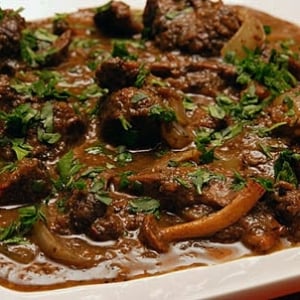

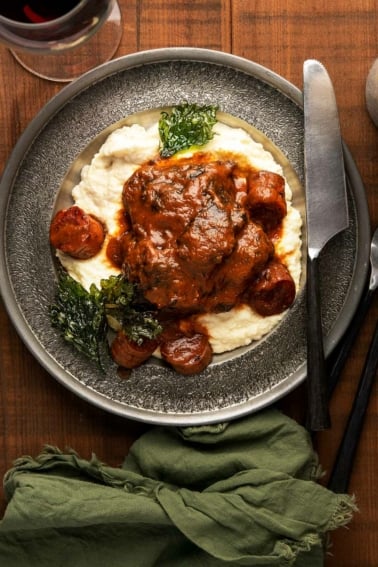
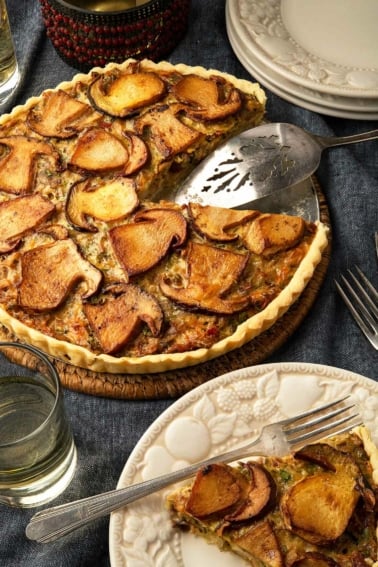
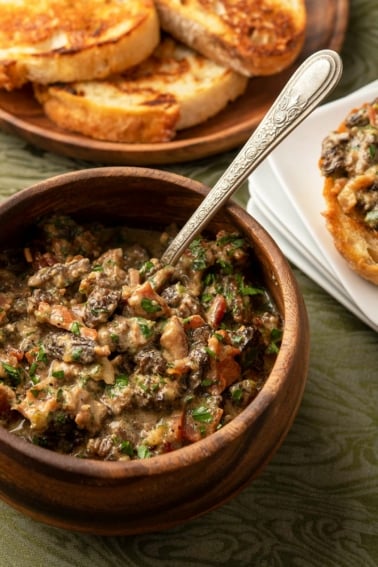
Will leftovers keep in the refrigerator, or is this best consumed straight away?
Peter: This one will keep a week or so in the fridge. Just reheat it gently.
The liver from the ingredient list has vanished somehow, just as in your other recipes after their recent update.
Hank,
Loved the recipe. Made it with snowshoe hare. Used 1 1/2 hare instead of one. Used beef broth, chantrelles, and a small piece of beef liver because I didn’t know at the time to save the livers. It’s an intimidating recipe but once done, it’s not so bad. I ve never had a bad recipe from you. Keep up the great work.
Mushroom curious:
In preparation for cooking this, I see the need for both 1/4 lb fresh mushroom and 1/2 Oz. dried mushrooms (presumably these are the chanterelles? Is this correct?).
I also see that chanterelles in step 10 and step 5 in making the civet. Would you be so kind as to clarify which is which and when?
Thank you very much,
TF
Tom: Hey there, I used fresh chanterelles, because I gather them. For a non-mushroom hunter, I would suggest 1/4 pound button mushrooms or shiitakes, and the 1/2 ounce dried porcini.
Great, I will try this!
South Dakota State is going to get their Jackrabbit Jugged by Ohio State on March 14.
further to mt last comments – Oh, and for mushrooms – I could not for love or money find chantarelle mushrooms, but fortunately I had some dried morels, and used them, that is a perfect substitute. Its bound to be a great season for them this year when the spring comes in CA
A hare sacrificed itself to me a couple of weeks ago in California by running headlong under the back wheel of my truck. Fortunately that was the only part crushed.
I’m not one to waste good wild game and hare is a favorite, (though I’ve only had it rarely) and being 2 minutes from home I stopped and picked it up. Cleaned and dressed, and in the fridge I began searching for recipes and found this one.
I let it age a couple of days, while I assembled the required ingredients. I marinated it for literally only an hour for time constraints, and then cooked it pretty much as stated. I used chicken livers instead of the hare liver, and no blood as I’d discarded these during dressing.
7 of us ate it, and the result was a resounding Fantastic! I think everyone, myself included were really surprised just how good this recipe is. It’s definitely on my list to repeat – and interestingly, this recipe doesn’t use garlic! That’s something I noticed is common to a lot of German recipes where onion is commonly the only allium used.
My dad died a few days ago. I was going through his papers & I found a recipe for Jugged Rabbit. But it’s completely different from yours. According to the one I found you need a rabbit cut into small pieces, salt & pepper, thyme, savory salt, celery seed, parsley flakes, ground cloves, bay leaves & bacon. You layer the rabbit & the spices & the bacon in a baking dish, add one cup water, cover & bake 2 hours at 350 or until tender. I haven’t tried this recipe (yet). What’s your opinion of it?
Lacee: That’s not a civet. It might taste fine, but it is not remotely what jugged hare is, at least historically speaking. Still, I’d give it a go. It’s your dad’s recipe, after all.
Blooming great recipe.
I have a hare coming in the post from Suffolk
Looking forward to this….
Hywel
Great recipe, Hank and very well written.
I just made made it yesterday but with a few changes which make the dish less complicated and healthier. I’m reporting just in case someone wants to try it and/or improve it.
First, I bought the whole hare but asked the butcher to de-bone it. I’ll use the bones with whatever meat left on them to make a sauce which will go very well with some large noodles ( two pidgeons with one stone…)
I cut the meat in chunks, washed it carefully then covered with red wine ( nothing special , a Sangiovese relatively young) and let it stay for one day ( could be two days). Then washed the meat, dried it and added to a Le. Creuset pot where I had already started browning in olive oil the cut pieces of carrots, celery, garlic and onion. After 5/10 minutes I added the full decanted content of two bottles of my own 1986 Chianti ( pure Sangiovese) and let everything cook (simmering) for about 8 hours. No blood, no liver, no thickening flour, etc.
After about 4 hours I took the lid off ( otherwise there would be no evaporation) added bay leaves, cognac, peppercorns ( plenty) cloves and cinnamon.
One could do any number of changes the basic idea being use good wine, not young, and cook slowly in a pot adding whatever seasonings and herbs one likes.
Forgot to say that the hare should be dry-aged for 4/7 days.
are you shittin me what a perfect recipe for a swamp rabbit from east of hathaway.thank you dwdoherty,jennings pls reply
Mr. Shaw,
I stumbled across this item by a happy accident. I’m not familiar with Jugged hare except through a Monty Python reference, but it was enough to get me reading. While I’m unlikely to try my hand at the recipe I very much enjoyed your writing style. Thanks for a very pleasurable few minutes.
David Alan Eadie
2 questions for you Hank;
1-Chile Paste? I don’t see it in your list of ingredients.
2-Is there any way to do this whole recipe on the stove? I don’t have an oven,
Thanks!
Michele: Skip the chile paste. I dropped it from the updated recipe. Sorry. Yes, you can. Just cook it on a slow burner and cover the pot.
Jim Rivis. you might be mixing up some time-honoured traditions here. Ferrets are used to flush underground rabbits, not for hunting hares – for hares you need a lurcher or a working greyhound. Burying meat for a couple of days while you walked around looking innocent and waited for a chance to retrieve it was an old poachers trick.
I don’t know where I picked up the following concept. It may be from my 1940’s North Yorkshire Moors childhood experiences, ‘ferreting’ at midnight with my foster grandfather. I seem to recall that a jugged hare started off by gutting the animal, wrapping the carcase in a clean sack, burying it 24″ deep in soil and compacting the soil sufficiently to discourage any oxygen reaching the meat. This would then remain underground for a week or more. The hare meat would become much more tender and begin to separate from the bone resulting in a far more tender end dish !
1 freshly shot Hare hanging in the pantry, waiting for it to hang for a few days then I will be giving this one a go…
Hank,
Like so many on your site, this looks like a great recipe and I plan on trying it for my family over the holidays. If using venison, what cut would you recommend? I am thinking maybe a “football roast” from the hind quarter? Any other changes that need to be made to the recipe if using venison instead of hare? Appreciate any input or tips.
Mark
Hi Hank. i write from rural Berkshire in England.
I have just bought a hare from the Wellington Estate.
Searching the internet for a good jugged hare recipe, I found yours and we tried it out yesterday (well for the last three days of toil and tears)
The end result was amazing and we were all really impressed.
I just wanted to write to thank you for exporting this back to us in the UK. I’ll keep looking out for recipes on your site and will keep you posted on eating on the wild side in England
Regards
Tom
I ordered a hare off the internet for £17 and decided to try your recipe. It was absolutely delicious and my family loved it! By the end of the cooking time the meat literally fell off the bone when I tried to take it out of the saucepan. It was the first time I have had hare but I shall certainly be having it again.
Unfortunately I improvised the butchery before I found your guide, but my method was pretty much the same. I was also lucky in that the liver was still attached, so I could use it for the thickening. I was wondering: is there anythinbg one can do with a hare’s kidneys? I took them out but wasn’t sure how to wash and prepare them so I ended up throwing them away, which seemed rather a shame.
I found your website looking for a hare recipe, but since then I have had a chance to look through it and found so many recipes I want to try! Unfortunately bear is simply unavailable in Britain, but I can easily obtain the other meats. I am considering cooking the venison steak Diane for my fifteenth birthday in a few weeks.
Thank you again for the fantastic recipe.